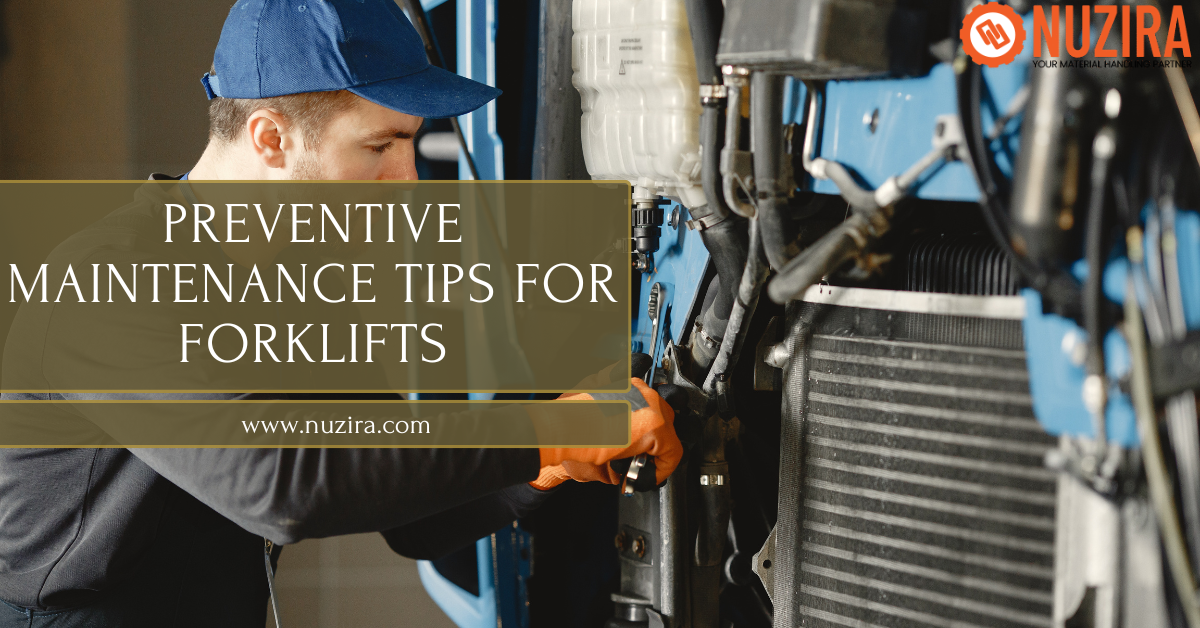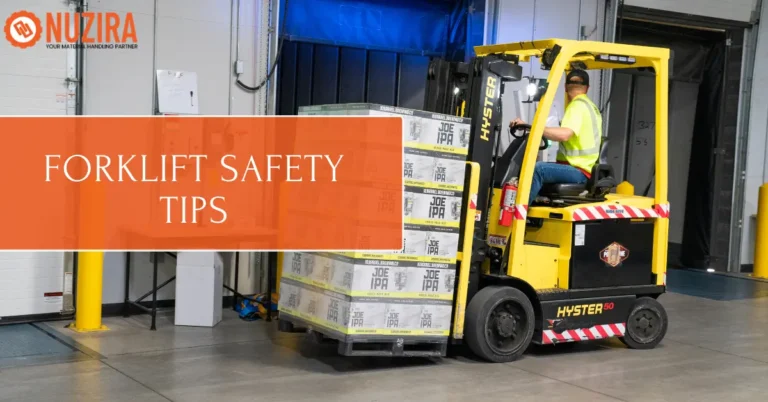Preventive Maintenance Tips for Forklifts
Preventive maintenance is one of the most effective ways to extend the lifespan of equipment, reduce costly downtime, and keep operations running without unexpected interruptions. Instead of waiting for machinery to break down, preventive maintenance takes a proactive approach by scheduling regular inspections, servicing, and minor repairs before issues escalate into major problems.
In this first section, we’ll cover what preventive maintenance is, why it matters, and how it forms the foundation for smooth operations.
Understanding Preventive Maintenance
Preventive maintenance refers to scheduled upkeep performed on machinery, tools, or systems to prevent failures and extend their useful life. Unlike reactive maintenance, which deals with breakdowns after they occur, preventive maintenance focuses on anticipating problems before they arise.
This process typically involves:
- Regular equipment inspections
- Cleaning and lubrication of moving parts
- Timely replacement of worn components
- Performance monitoring through checklists or digital systems
By creating a schedule and sticking to it, businesses can minimize unexpected disruptions and maintain steady productivity.
Why Preventive Maintenance Is Essential
The true value of preventive maintenance lies in its ability to reduce risks and increase efficiency. Here are some key reasons why it is considered an essential practice across industries:
- Minimizes Downtime
Equipment breakdowns often happen at the worst possible times. Preventive maintenance helps reduce surprise failures, keeping projects and production schedules on track. - Lowers Repair Costs
Catching a problem early, such as a worn belt or low lubrication levels, is far cheaper than replacing a major component after it fails. - Improves Safety
Well-maintained equipment poses fewer risks to operators. For example, machines with properly functioning brakes, sensors, or hydraulics create safer working environments. - Boosts Equipment Lifespan
Regular upkeep slows down wear and tear, allowing businesses to maximize the value of their assets. - Supports Operational Efficiency
When equipment runs smoothly, energy consumption is often lower, and output quality improves.
Preventive Maintenance in Industrial Settings
Preventive maintenance plays a particularly crucial role in industrial operations, where heavy-duty machinery is the backbone of daily productivity. Industries such as construction, manufacturing, and material handling rely on this approach to keep operations efficient.
For instance, forklifts, conveyors, and cranes often operate under demanding conditions. Without a maintenance routine, even small issues—like hydraulic leaks or worn-out bearings—can lead to extended downtime and safety hazards. By scheduling maintenance checks, companies can prevent disruptions and keep workflow steady.
Practical Preventive Maintenance Tips and Best Practices
Now that we’ve established what preventive maintenance is and why it matters, let’s explore actionable tips that businesses and individuals can implement. These strategies not only keep equipment in peak condition but also create a more reliable and cost-efficient workflow.
Create a Structured Maintenance Schedule
One of the most important steps is to establish a clear and consistent maintenance schedule. Without structure, even well-intentioned maintenance efforts can fall through the cracks.
- Daily checks: Operators should quickly inspect equipment before use, looking for visible damage, fluid leaks, or abnormal noises.
- Weekly or monthly tasks: Cleaning, lubrication, and minor adjustments ensure smooth operation.
- Quarterly or annual servicing: More in-depth inspections, part replacements, and software updates help extend overall equipment life.
Consistency is key—documenting tasks in logs or digital systems ensures no steps are skipped and provides a record of upkeep.
Keep Equipment Clean and Lubricated
Dust, dirt, and debris are silent enemies of machinery. Over time, they can clog filters, wear down gears, and cause overheating. Regular cleaning prevents buildup and ensures efficiency.
Equally important is lubrication. Moving parts like chains, bearings, and gears require the right type of lubrication to reduce friction and prevent premature wear. Always use manufacturer-recommended lubricants and avoid over-lubrication, which can attract dirt and cause its own problems.
Train Staff to Spot Warning Signs
Operators are often the first line of defense when it comes to identifying maintenance issues. Training staff to recognize early warning signs—such as unusual vibrations, inconsistent performance, or leaks—helps catch problems before they become costly failures.
Encouraging a culture of accountability, where workers feel empowered to report issues without hesitation, ensures small fixes aren’t overlooked.
Leverage Technology for Maintenance Tracking
Modern preventive maintenance goes beyond manual checklists. Many businesses now use Computerized Maintenance Management Systems (CMMS) or mobile apps to streamline upkeep. These tools:
- Track maintenance schedules automatically
- Send reminders for upcoming inspections
- Keep digital logs of all performed tasks
- Help predict failures through data analysis
By adopting digital solutions, companies can reduce human error, improve documentation, and make maintenance programs more efficient.
Prioritize Critical Equipment
Not all machines carry the same weight in daily operations. A conveyor in a production line, for example, may be more critical than an auxiliary machine used less frequently. Prioritizing critical equipment for preventive maintenance ensures the most essential assets receive attention first.
This strategy balances resources, focusing time and budget where breakdowns would have the biggest impact.
Common Mistakes to Avoid in Preventive Maintenance
Even with the best intentions, some businesses make mistakes that reduce the effectiveness of preventive maintenance. Avoiding these pitfalls can help you get the most from your program.
Ignoring Minor Issues
A small leak, loose bolt, or minor noise may seem harmless at first, but over time these small problems can escalate into costly breakdowns. Addressing them early saves money and prevents downtime.
Skipping Scheduled Tasks
Delaying or skipping scheduled maintenance often leads to bigger problems later. Consistency is what makes preventive maintenance effective.
Relying Only on Reactive Fixes
Some organizations fall back into a reactive approach, waiting until something breaks before acting. This defeats the purpose of preventive maintenance and often results in higher repair costs.
Using Incorrect Parts or Lubricants
Always follow manufacturer guidelines for parts and lubricants. Using substitutes might seem like a quick solution but can shorten equipment lifespan and void warranties.
Long-Term Benefits of Preventive Maintenance
When done correctly, preventive maintenance delivers powerful long-term advantages:
- Lower operational costs: Regular upkeep reduces expensive emergency repairs.
- Higher productivity: Equipment runs efficiently with fewer unexpected stoppages.
- Extended lifespan: Businesses get more value from their machinery investment.
- Safer work environments: Well-maintained equipment minimizes risks for operators.
In industries like manufacturing, logistics, and material handling, these benefits directly impact both efficiency and profitability.
Conclusion
Preventive maintenance isn’t just about keeping machines in good shape—it’s about ensuring safety, reducing costs, and maximizing efficiency across operations. By following a structured schedule, training staff, using the right tools, and avoiding common mistakes, businesses can keep their equipment running smoothly and reliably for years to come.
Now is the perfect time to review your maintenance practices and see where you can improve. Taking action today will save money, increase safety, and give you peace of mind tomorrow.
Ready to take your operations to the next level? Visit our website to explore more resources and solutions tailored to your needs.





